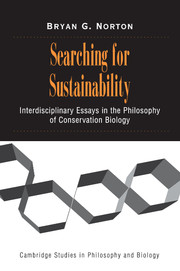Book contents
- Frontmatter
- Contents
- Searching for Sustainability
- General Introduction: An Interdisciplinary Experiment
- I PRAGMATISM AS AN ENVIRONMENTAL PHILOSOPHY
- II SCIENCE, POLICY, AND POLICY SCIENCE
- III ECONOMICS AND ENVIRONMENTAL SUSTAINABILITY
- IV SCALING SUSTAINABILITY: ECOLOGY AS IF HUMANS MATTERED
- V SOME ELEMENTS OF A PHILOSOPHY OF SUSTAINABLE LIVING
- VI VALUING SUSTAINABILITY: TOWARD A MORE COMPREHENSIVE APPROACH TO ENVIRONMENTAL EVALUATION
- 23 Commodity, Amenity, and Morality: The Limits of Quantification in Valuing Biodiversity
- 24 The Cultural Approach to Conservation Biology
- 25 Evaluation and Ecosystem Management: New Directions Needed?
- 26 What Do We Owe the Future? How Should We Decide?
- 27 Environmental Values and Adaptive Management, with Anne Steinemann
- Index
- References
24 - The Cultural Approach to Conservation Biology
Published online by Cambridge University Press: 21 January 2010
- Frontmatter
- Contents
- Searching for Sustainability
- General Introduction: An Interdisciplinary Experiment
- I PRAGMATISM AS AN ENVIRONMENTAL PHILOSOPHY
- II SCIENCE, POLICY, AND POLICY SCIENCE
- III ECONOMICS AND ENVIRONMENTAL SUSTAINABILITY
- IV SCALING SUSTAINABILITY: ECOLOGY AS IF HUMANS MATTERED
- V SOME ELEMENTS OF A PHILOSOPHY OF SUSTAINABLE LIVING
- VI VALUING SUSTAINABILITY: TOWARD A MORE COMPREHENSIVE APPROACH TO ENVIRONMENTAL EVALUATION
- 23 Commodity, Amenity, and Morality: The Limits of Quantification in Valuing Biodiversity
- 24 The Cultural Approach to Conservation Biology
- 25 Evaluation and Ecosystem Management: New Directions Needed?
- 26 What Do We Owe the Future? How Should We Decide?
- 27 Environmental Values and Adaptive Management, with Anne Steinemann
- Index
- References
Summary
One lazy Saturday afternoon I was walking on the beach on the North end of Longboat Key, Florida – the last unspoiled strip of beach on that once-beautiful island. The currents in Longboat Pass had shifted and were dumping sand in a crescent spit out into the Gulf of Mexico. The new sandbar was forming a tidal lagoon. As I walked along on the sandbar, I came face to face with an eight-year-old girl as she clambered from the lagoon onto the ledge of the sanbar. She was cradling a dozen fresh sand dollars in her arms. Looking past her, I saw her mother and older sister dredging sand dollars from the shallow lagoon. They walked back and forth, systematically scuffing their feet through the soft sand. As they dislodged the sand dollars, they picked them up and held them for the little girl, who transported and piled them by their powerboat that was beached on the sandbar. A pile of several hundred had accumulated on the sand by the boat.
“You know, they're alive,” I said indignantly.
“We can bleach'em at home and they'll turn white,” the little girl informed me. I could hardly argue with that.
“Do you need so many?” I asked.
“My momma makes'em outta things,” she explained.
I pressed my case: “How many does she need to make things?”
“We can get a nickel apiece for the extras at the craft store,” the little girl replied.
- Type
- Chapter
- Information
- Searching for SustainabilityInterdisciplinary Essays in the Philosophy of Conservation Biology, pp. 467 - 477Publisher: Cambridge University PressPrint publication year: 2002



